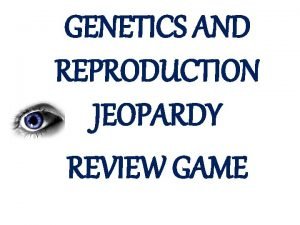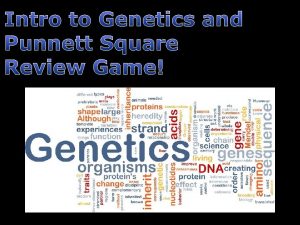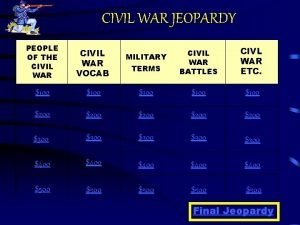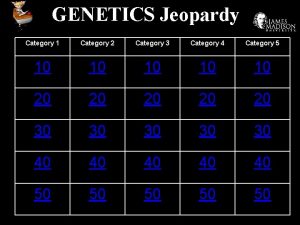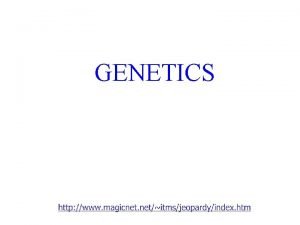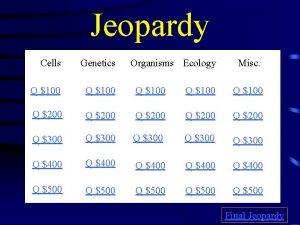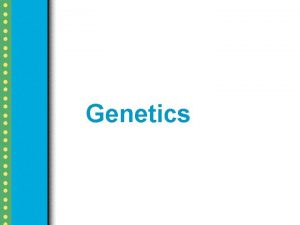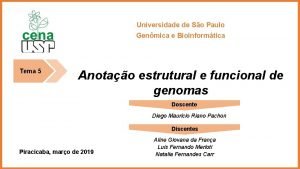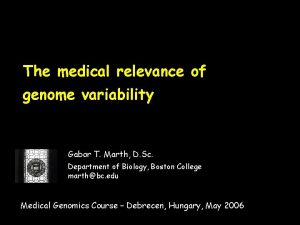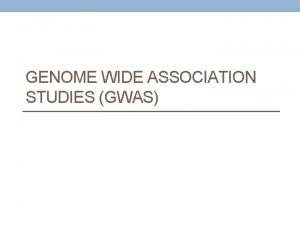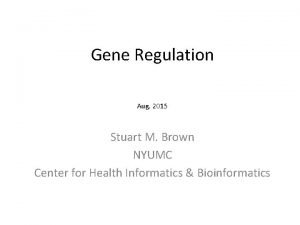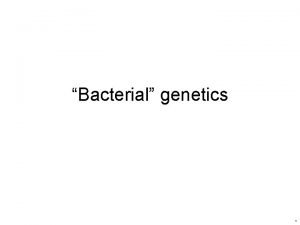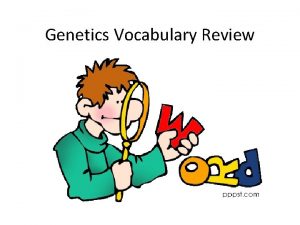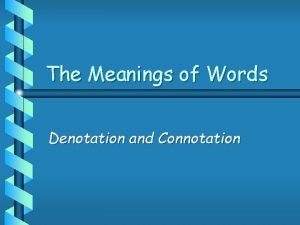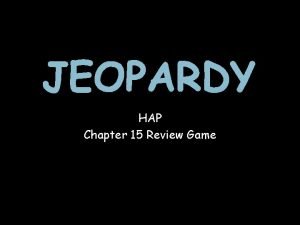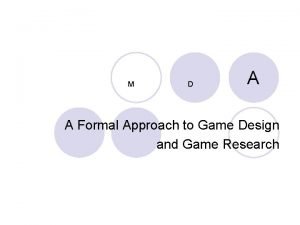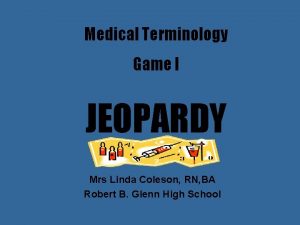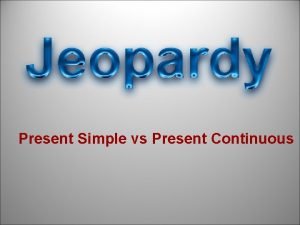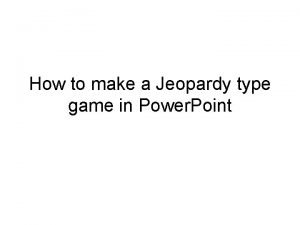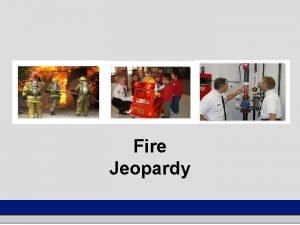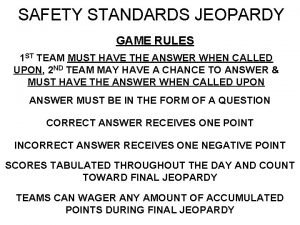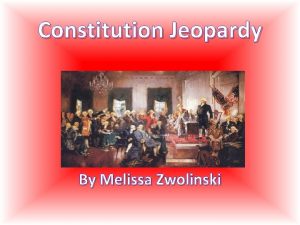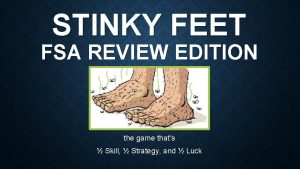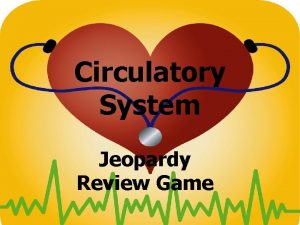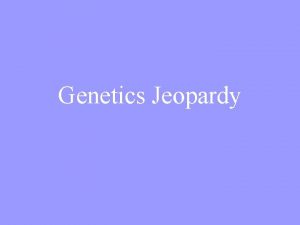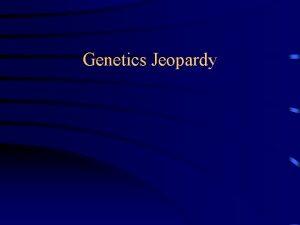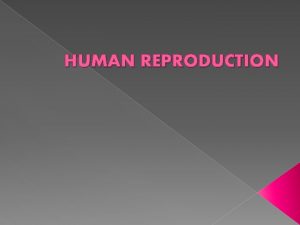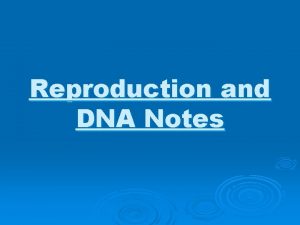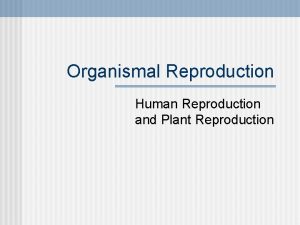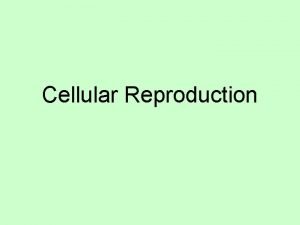GENETICS AND REPRODUCTION JEOPARDY REVIEW GAME GENETICS AND



























































- Slides: 59

GENETICS AND REPRODUCTION JEOPARDY REVIEW GAME

GENETICS AND REPRODUCTION REVIEW GAME JEOPARDY Q 5 Q 9 Q 13 Q 17 Q 21 Q 2 Q 6 Q 10 Q 14 Q 18 Q 22 Q 3 Q 7 Q 11 Q 4 Q 8 Q 12 Q 15 Q 16 Q 19 Q 23 Q 20 Q 24

In humans, the male sex cell is called _______ and it is produced in the ________ which are located in the ________ of a male.

• Sperm • Testes • scrotum Slide 2

• In humans, the female sex cell is called the _____ and it is developed/produced in the woman’s _______ and get sent down through the ______ to the _________.

• Egg • Ovaries • Fallopian tubes • Uterus Slide 2

(*made up example) If there were 3 alleles for cat eye color (G=green, R=gray and B=blue) a. List all the genotypes that exist. b. What allele relationship(s) does this example show?

• a. GG, RR, BB, GR, GB, RB (these can be written in any order) • b. incomplete dominance AND multiple alleles! Slide 2

Write an “A” for asexual reproduction or “S” for sexual reproduction for each of the following: a. 2 parents involved b. 1 parent involved c. relatively quick process d. offspring have identical DNA to parent(s) e. all animals, plants and humans use this form f. DNA of offspring is different from parent(s) g. relatively slow process h. offspring’s appearance differs from parent(s) i. some plants and animals reproduce this way j. Offspring’s appearance is identical to parent(s)

a. S b. A c. A d. A e. S f. S g. S h. S i. A j. A Slide 2

• When a sperm and an egg join together, the process is called ________ and the product of their joining is called a _______. If a sperm and an egg don’t join together, the egg ______________________.

• Fertilization • Zygote • Leaves the body through menstruation (the woman has her period) Slide 2

• If mosquitoes have 6 chromosomes, describe when and how a mosquito gets its chromosomes. Include numbers in your answer!

• 3 chromosomes from an egg cell pair up with 3 chromosomes from the sperm cell during fertilization. Slide 2

A child has the genotype Bb for the blue or brown eye color gene. Write all the combinations of genotypes that his parents could have. Sample format: ____ and ____ ( fill a genotype in each blank)

The parents could have: BB and bb BB and Bb Bb and bb Slide 2

• All cells in the human body have ______ chromosomes except for the __________ which have ____ chromosomes.

• 46 • Sex cells • 23 Slide 2

a. b. Describe what meiosis creates and how it does that. If this was a starting body cell in a kangaroo: draw what one of the final cells created (from meiosis) would look like.

a. Meiosis is what creates sex cells. Each starting parent cell makes a copy of its chromosomes, then the cell divides into 2 identical cells. Then the chromosome pairs separate in each cell and each cell divides again, creating 4 different sex cells that each have half of the chromosomes (and are unpaired) that the original cell had. b. . Slide 2

• The genetic material that gets carried from parents to offspring are called _____. There are different versions of these. The different/specific versions of these are called _______. They get carried from parents to children on the _________.

• Genes • Alleles • Chromosomes (if you said sex cells, that is acceptable too) Slide 2

• Explain how children get their genotypes for each gene. Include when that happens as well.

• A child gets 1 allele from its mom’s egg cell and 1 allele from its dad’s sperm cell for each gene during fertilization. Slide 2

• What is the difference between genotype and phenotype and use the blue eye/brown eye example to support your answer.

• A genotype is the genetic make-up of a gene. (the 2 alleles). –Example: BB, bb, or Bb are the genotypes for the blue or brown eye color gene. • A phenotype is the physical appearance that occurs due to a genotype. Slide 2 –Example: blue eyes or brown eyes

a. What is the difference between homozygous and heterozygous genotypes? b. Include/label the examples for the blue/brown eye gene.

• Homozygous genotypes have 2 identical alleles for a gene. –BB or bb • Heterozygous genotypes have 2 different alleles for a gene. –Bb Slide 2

• What is the purpose of a Punnett square?

• To show the probability (chances) of how the alleles will mix during fertilization. It takes the genotypes of both parents and shows the possibilities and chances of genotypes that their children can get. Slide 2

1. Fill out a Punnett square for a mom with Ww and a dad with ww. 2. What are the chances that their kids will have a widow’s peak? 3. What are the chances that their kids will have a straight hairline? 4. What are the chances that their kids will have a homozygous dominant genotype?

Mom W w D w A D w Ww ww 2. 50% 3. 50% 4. 0% Slide 2

• Every time a child (human) is born, what are the chances the baby will be a boy and what are the chances the baby will be a girl? • What determines the sex of a baby? Explain.

• There is always a 50% chance for a boy and a 50% chance for a girl. • The father determines the baby’s sex because males have the chromosomes XY and females have XX so females always pass on an X; it is the male’s sperm cell that either passes an X (girl) or Y (boy) Slide 2

In human blood type, the alleles are: A B I = type A I = type B & i = type O. a. Explain the relationship that the alleles have with each other. b. Name the blood types that a person would have with the following genotypes: 1. IAi 2. IAIB 3. ii 4. IBIB

a. IA and IB are codominant and i is recessive to IA and IB. b. 1. Type A 2. Type AB 3. Type O 4. Type B Slide 2

A child has blood type AB. Is it possible for the child’s parents to have the following combinations of genotypes? A A B 1. I I and I i A A A 2. I I and I i A B B B 3. I I and I I A B 4. I I and ii

1. YES 2. NO 3. YES 4. NO Slide 2

• Explain what it means for alleles to have a dominant/recessive relationship.

• If an allele is dominant and is present in a genotype it will mask/overpower a recessive allele. Dominant alleles are represented by capital letters and recessive alleles are represented by lowercase letters. The only time a recessive phenotype will show is if both recessive alleles make up a genotype. With a heterozygous genotype, the phenotype for the dominant allele will overpower the recessive allele and show Slide 2 through.

• This is NOT true BUT if hair type alleles were HC= S curly hair and H = straight hair what would your phenotype be if you had the heterozygous genotype?

• You would have different sections of straight hair and sections of curly hair. Slide 2

• When R = red flowers and B = blue flowers: 1. What would the heterozygous genotype be between them? 2. What would the phenotype be? 3. What kind of relationship do these alleles have with each other?

• 1. RB • 2. purple • 3. incomplete dominance Slide 2

• Indentify each genotype as heterozygous OR homozygous: a. WW R R b. F F R W c. P P d. SS e. Rr f. BW B g. I i

• a. homozygous • b. homozygous • c. heterozygous • d. homozygous • e. heterozygous • f. heterozygous • g. heterozygous

(*made up example) Name the allele relationship shown from each gene (a-c) below: Gene Genotypes and phenotypes a. Flower color RR = red RY = orange b. c. Stem height Leaf texture HH = tall Hh = tall TBTB = TBTS= bumpy and smooth areas YY = yellow hh = short TSTS = smooth

• a= incomplete dominance • B= dominant/recessive • c= codominance

a. In humans, where does fertilization usually occur? b. If a zygote is created, where does it stay to develop throughout the woman’s pregnancy?

• a. in a fallopian tube • b. In the uterus






(Not on test 2017) a. Name the 2 main types of twins b. Describe how each type is formed c. Explain what the sexes can be for each type of twin. (Do they have to be the 2 boys or 2 girls or could the twins be 1 boy and 1 girl? )

• a. fraternal and identical • b. Fraternal-2 eggs get fertilized by 2 separate sperm. Identical- 1 egg gets fertilized by 1 sperm and then the zygote splits into 2. • c. fraternal- can be 2 boys, 2 girls, or 1 boy & 1 girl identical- must be 2 boys or 2 girls


 Genetics jeopardy review game
Genetics jeopardy review game Punnett square game
Punnett square game Asexualk
Asexualk Romeo and juliet act 1 jeopardy
Romeo and juliet act 1 jeopardy Sexual reproduction vs asexual reproduction venn diagram
Sexual reproduction vs asexual reproduction venn diagram Sexual and asexual reproduction venn diagram
Sexual and asexual reproduction venn diagram Sexual reproduction and genetics section 1 meiosis
Sexual reproduction and genetics section 1 meiosis Mendelian genetics
Mendelian genetics Sexual reproduction and genetics section 1 meiosis
Sexual reproduction and genetics section 1 meiosis Chapter 10 sexual reproduction and genetics
Chapter 10 sexual reproduction and genetics What is gettysburg
What is gettysburg Natural selection jeopardy
Natural selection jeopardy World war 1 jeopardy questions
World war 1 jeopardy questions Ap world history jeopardy review game
Ap world history jeopardy review game Apwh final exam review
Apwh final exam review Reproduction review
Reproduction review Genetics jeopardy
Genetics jeopardy Genetics jeopardy
Genetics jeopardy Genetics jeopardy
Genetics jeopardy What does the notation tt mean to geneticists
What does the notation tt mean to geneticists Nature review genetics
Nature review genetics Nature review genetics
Nature review genetics Gwas
Gwas Nature review genetics
Nature review genetics Nature review genetics
Nature review genetics Nature review genetics
Nature review genetics Genetic vocabulary review
Genetic vocabulary review Genetics vocabulary review
Genetics vocabulary review Ginny was a nosy child
Ginny was a nosy child Connotation and denotation jeopardy game
Connotation and denotation jeopardy game Connotation and denotation jeopardy game
Connotation and denotation jeopardy game Jeopardy anatomy and physiology game
Jeopardy anatomy and physiology game A formal approach to game design and game research
A formal approach to game design and game research Jeopardy game maker
Jeopardy game maker Jeopardy game maker
Jeopardy game maker Animal farm jeopardy
Animal farm jeopardy Prefix jeopardy
Prefix jeopardy Bill of rights game jeopardy
Bill of rights game jeopardy Jeopardy game rules
Jeopardy game rules Mental health jeopardy game
Mental health jeopardy game Christmas jeopardy questions
Christmas jeopardy questions Classifying triangles jeopardy game
Classifying triangles jeopardy game Jeopardy game music
Jeopardy game music Let's play jeopardy
Let's play jeopardy Factor jeopardy
Factor jeopardy Jeopardy science questions
Jeopardy science questions Present simple powerpoint
Present simple powerpoint 21 jump street movie poster
21 jump street movie poster Jeopardy subject verb agreement
Jeopardy subject verb agreement Jeopardy game background
Jeopardy game background Jeopardy game builder
Jeopardy game builder Jeopardy vocabulary game
Jeopardy vocabulary game Jeopardy statistics
Jeopardy statistics Medicare jeopardy game
Medicare jeopardy game Stuttering jeopardy
Stuttering jeopardy Jeopardy game rules
Jeopardy game rules La gente que contagia alegria deberia ser eterna
La gente que contagia alegria deberia ser eterna Constitution jeopardy game
Constitution jeopardy game Career jeopardy game
Career jeopardy game Fsa writing review jeopardy
Fsa writing review jeopardy
